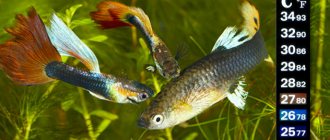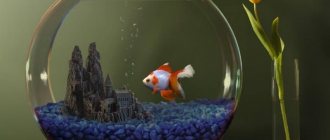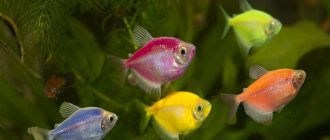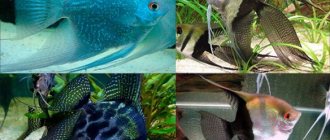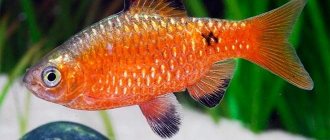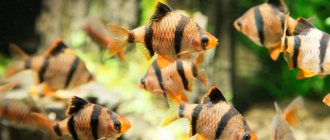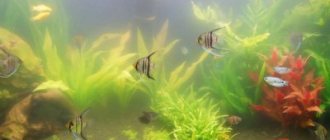Natural habitat conditions
The first mention of the minor dates back to 1882. The natural habitat for the serpas is Paraguay. The fish can also be found in countries such as South Africa, Brazil and Guiana. The species is distributed in large quantities and prefers stagnant waters rich in green vegetation. Serpas always stay away from the depths in river tributaries, ponds and small lakes.
The main food for fish is particles of underwater plants, insects and larvae. And although the minors lead a school life, fights constantly take place in the clans, during which the fish grab each other’s fin parts.
Appearance
Serpas appearance:
- Size – characterized by small sizes and reach a maximum of 5 cm in length.
- The body has a narrowed and high structure, like that of all tetra fish.
- The dorsal fin is vertical, quadrangular in shape, elongated in some individuals.
- Color. The body is fiery in color with bright tints of scales. Individuals have a bluish-black spot in the middle near the gills and dark black fins. They may have an eye-catching white border along the edge.
With careful care and absence of diseases, individuals can live from 4 to 6 years.
Description and natural habitat
Minor's homeland is located in the tropical forests of South America, more precisely in Brazil. This ray-finned fish of the characin family prefers quiet, darkened backwaters with or without slow currents.
The body of the fish is strongly flattened and slightly elongated in length; from the side it evokes an association with an asymmetrical rhombus, tapering towards one of the apexes. A striking distinctive feature is the dorsal fin, which is rectangular in shape and extended upward.
Photo gallery Minor:
The color brightens from the back to the belly and varies from dark olive to red. At the base of the gill cover there is a transverse elongated black spot. The fin on the back is resin-colored and is emphasized by a white stripe along the contour. The lower ones are orange-red with a black border, the tail is scarlet, of a classic shape.
Sexual differences are striking, females are larger and have a denser abdomen. Males are slimmer and more richly colored.
Minors live in flocks in the middle and lower layers of water. They feed mainly on plant foods, but can also eat insect larvae. They begin to reproduce when they reach the age of 8-10 months, through spawning.
Adults grow up to 4.5 cm in length and live up to 6 years under favorable circumstances.
Conditions for keeping serpas in a home aquarium
Minor is a fish that is not only awarded with natural beauty, but is also characterized by the fact that it does not require complex care. This is what distinguishes almost all types of tetras. You cannot keep one or two individuals, because the serpas is a schooling fish. The aquarium should have at least 6 specimens of this species, as well as other aquarium fish.
For a flock of 6 minors, a container of 50-70 liters of water is enough.
In addition, it is necessary to take into account a number of rules to maintain the health of pets in good condition:
- Lighting . It is required to create dim lighting.
- Filtration . Installing a filter is mandatory, as it will be useful to simulate at least a slight current (water flow) in the aquarium. In addition, the filter is good at filtering liquid from contaminants. However, a water change is still required: the percentage of fresh liquid per week should be 25%. If you ignore this requirement and do not change the water, there will be too many nitrates in it, which will have a detrimental effect on the health of the fish.
- Vegetation . To achieve shading, plants adapted to swimming rather than living in the ground can be released onto the surface of the water.
- Decorating an aquarium . The aquarist should make sure that the minor fish can hide. In a tank, algae thickets and wooden driftwood are excellent safe places.
- Soil . The ideal option would be not very large black stones, emphasizing the delightful color of the serpas. Gravel and dark sand are also suitable.
- Water parameters are 5.5-7.5 PH and 5-20 dGH, that is, the state of the water can be described as sour and soft. The temperature comfortable for fish is +23-27°C.
And although the minor, due to its distribution, has become accustomed to a variety of conditions and parameters, it is better not to take risks and create the most acceptable indicators. The first signal indicating that the fish feels uncomfortable and even painful in the created ecosystem is a decrease in color saturation.
Maintenance and care
The red tetra is not picky about its living conditions, but to ensure its comfort, you need to follow some recommendations.
Water parameters
To contain serpas, water must meet the following parameters:
- Temperature – 23 – 26°C;
- Hardness – 12 – 18°;
- Acidity – 5.5 – 7.3 pH.
Requirements for an aquarium
It is better to house these aquarium inhabitants in flocks of 6 - 8 individuals. Due to the small size of the serpas, 10-12 liters of water per fish is enough. But it is still better to choose an aquarium with a volume of at least 100 liters in order to provide the animal with comfort and freedom of movement.
The aquarium must have a lid, because these fish love to jump out of the water.
Lighting
The lighting in the aquarium should be dim, slightly dim and diffused. It is advisable to use fluorescent lamps, which should be turned on for 10 - 12 hours a day.
Changing water
A weekly water change is required, which should be about 25 - 30% of the total volume. It is advisable to add a small amount of peat to the new water, which will make it more acidic. These fish do not like fast currents, so the filter should be set to low power and directed towards the glass to reduce the intensity of the current. Aeration is required .
Soil and plants
You can choose any soil for keeping fish: sand, small stones, pebbles, granite chips or gravel. But red tetras look more attractive against a dark or black background. The aquarium must have dense plants, some of which should float on the surface, scattering light, and the other part should be located at the back and side walls of the reservoir. Preference should be given to:
- Mhu;
- Echinodorus;
- Fern;
- Cryptocoryne;
- Elodea;
- Duckweed (it is placed on the surface of the water).
Plants need to be firmly anchored in the soil.
Scenery
Red tetras do not need a lot of cover. But to create the overall picture of the aquarium, you can add driftwood, one or two grottoes, a cave and branches. These items will help recreate a natural habitat and contribute to the appearance of shady areas, which is important for fish.
You should also put some dry leaves of various trees (oak, birch, aspen) and pine cones on the bottom of the aquarium. These items will not only decorate the pond, but also over time, during the process of decomposition, will make the water softer, which has a beneficial effect on the health of the fish.
What to feed the minors
Aquarium sickles are suitable for eating all types of food: both live and frozen and artificial. High-quality flakes are quite suitable for the constant basis of the diet. And as an additive for complete nutrition, it is worth giving bloodworms and tubifex. It is worth considering that all food should be crushed and small in size, because tetra fish have a small mouth. It is possible to fortify the diet by feeding tiny insects, aquatic crustaceans and enchytraeus.
To maintain the health of the minors, it is necessary to periodically introduce food of plant origin.
Only certain types can be given for food: spinach, pinnate, duckweed, green lettuce leaves and dandelion stems. When keeping minor fish, you need to try not to give them too much food. Overfeeding will inevitably lead to disruption of the balance created in the aquarium. The fish may start to get sick. The ideal amount of food is calculated as follows: serpas should eat it in just a few minutes. No more, no less.
Breeding Minors
The process of increasing the number of individuals in a flock is not very complicated. Reproduction can be carried out either in pairs or in groups in which there are approximately the same number of males and females. The most important thing for successful breeding is the creation of the correct spawning conditions and the selection of strong breeding individuals. Minors are ready to produce eggs at 7-8 months of their life.
Preparing the spawning tank. The spawning aquarium can be small (6-7 liters is enough). The lighting is weak. The presence of small-leaved aquatic plants in the container is mandatory. The ideal option would be Java moss. It is worth laying a separator mesh at the bottom, but soil is not needed in the spawning tank.
Water must be poured in a layer of about 10-15 cm and maintain the following indicators:
- hardness – 8 dGH;
- acidity – at least 6 pH;
- temperature – +27°C.
Parental preparation and spawning. Individuals that have been selected for spawning feed abundantly. Live food should be a priority, and the more of it, the better. This is done so that males become more active, and females noticeably gain weight. Before this stage, the specimens that you like for the intended spawning should be kept separately from each other.
Spawning usually begins at dawn. A pair of minor fish lay eggs on the leaves of plants (this is about 300 eggs at a time). Immediately after this process, the fish must be placed in their usual aquarium for habitat. The spawning tank is removed to a dark place to preserve the eggs, which are very photosensitive. Healthy minor caviar should be pinkish in color with a yellow tint. After hiding the breeding aquarium, it would not be a bad idea to add a few drops of methylene blue to the water.
Caring for the fry. The fry hatch from the eggs after two days. They feed from the yolk sac until they swim on their own after 3-5 days. As soon as the fry start swimming, you need to start caring for them. At the initial stage, babies are fed egg yolk and ciliates. As the former fry grow, you can begin to introduce Artemia nauplii and larger types of food, such as rotifers, into the diet.
Lack of filtration in the spawning tank will quickly lead to water pollution. Once every few days it must be replaced with a fresh one, without resorting to the help of an aerator and filter. The resulting offspring should not be placed in a common aquarium until the fish are completely stronger and grow up.
Contents of minors
Keeping a minor in an aquarium is quite simple. Minors are schooling fish, so it is recommended to keep them in a group of 4 or more. The volume of the aquarium should be at least 40 liters (10 liters for one or two individuals).
Optimal water parameters: temperature 22-25°C, dH 2-20°, pH 6.4-7.5. It is important to change 1/5 of the volume of water weekly to fresh, settled water.
Soil: dark sand or gravel.
The lighting should not be constant, so areas with shade are needed in the aquarium.
It is recommended to plant the aquarium with dense vegetation (echinodorus, Java moss, cryptocorynes, Thai fern), but at the same time leave enough space for free swimming.
Any other peaceful fish will be suitable as neighbors for minors, except for veil-shaped fish, the long thread-like fins of which minors love to gnaw.
The benefits of minor fish for humans
Flocks of minors are not only interesting to watch. Psychologists note that this also has a beneficial effect on a person’s well-being and mood for the whole day. Cheerful fish frolicking in an aquarium introduce you to a harmonious state of meditation, calming your nerves, perfectly lowering high blood pressure, and putting you in a peaceful, friendly and philosophical mood.
Even a beginner in the aquarium business can get himself some minor fish and care for them. Serpas, which do not require enormous care, will become friends who bring joy for quite a long time, if you do not make serious mistakes in caring for them.
Character and compatibility
Minors have a rather peaceful disposition. They prefer to stay in flocks of 6-8 individuals.
If you keep them alone, they can begin to attack other small fish or even their fellow fish. They especially do not like slow veiled ones; they gnaw off their fins and tails.
Almost all peaceful, active fish of approximately the same size and temperament, with the exception of the above, can become neighbors for minors.

